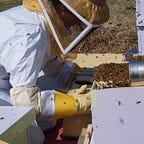The Very Hungry Bee: Ravenous Bees Go on a Feeding Frenzy During Complete Metamorphosis
Because bees are holometabolous insects, they go through the four stages of complete metamorphosis. Like butterflies, bees go through ups and downs in storing and eating. As many will recall from the book, The Very Hungry Caterpillar, the caterpillar ate everything in its path, eating anything and everything. Bee larvae are similar and can be aggressive and destructive during this stage. Knowing bees go through complete metamorphosis opens a can of questions, including if bees cocoon. The answer is that although some species of bees do not coon any longer, there are two families characterized by their long tongues who do cocoon to this day.
A Shorter Metamorphosis in Bees Saves Lives
Scientists believe that the shorter stage lengths and overall briefer length of metamorphosis from egg to adult in bees offer extra layers of protection. When the cocoon protects the larvae with a seal in the pupation stage, bees are entirely redesigned. A longer reconfiguring and reassembly would allow more things to go wrong. Predators, infections, and dealing with heavy winds or other harsh weather leave cocooned bees vulnerable, so the stages are believed to be shorter than other holometabolous insects. Something else unique to adult bees is that they may remain in the cocoon after reaching this final stage if they like.
Most Beekeepers Have Never Seen Bee Cocoons
Although some species of bees do cocoon, beekeepers will be hard-pressed to find them in their hives. Well-known to the beekeeping community, even though bees do cocoon, it is only easy to see if you raise Mason Bees or another species within the Megachilidae family. Mason Bees cocoon in tubes, and most beekeepers provide the conduits for this group of bees. In providing these tubes, keepers of Mason Bees must also wash, dry, and store these tubes every year so that dirt, feces, and other diseases do not negatively affect the following year’s cycle.
As with ensuring enough food and water, beekeepers must also provide enough space for bees to undergo complete metamorphosis. Beekeepers have an active role in the seasonal laying of eggs. Becoming a beekeeper is like caring for pets because they have needs and personalities!
Bees Through the Stages
When bee eggs are laid, this is the storage phase of food. It is considered a time of fasting because when the bees move into the larva stage, they eat like there is no end. Larvae are aggressive, eat constantly, and can destroy plants, leaving nothing but veins. As imagined, farmers are not thrilled as the larva stage can result in pest problems and devastate crops. As bees move from larva to pupa, cocooning occurs in those that still build cocoons. Other bee species use substances from the queen and the hive to cover up and protect developing bees from the elements and predators. As mentioned, bees have shorter lengths through the stages; the pupa stage is usually around one week. Once bees reach adulthood, they can stay in their protective space for a time.
Why Don’t All Bees Cocoon
It is not known precisely why only particular bee species cocoon, but it is thought that fewer bee species have continued the cocooning process over time. The adaptation and useability of other substances created in the hive that form strong protection may have led to the abandonment of cocooning by other species. The gland by the stinger used to cocoon in some species has alternative uses in others. The gland’s purpose depends on the bee’s species and the role of individual bees in the hive.
The female bees have a Dufour gland that can spin a cocoon and secrete pathogen-resistant substances that can be painted on the cell walls and provide enough protection. Other species use this same gland to build nests, and others use it to increase the release of pheromones. Nature is a beautiful mystery.
Beekeepers Unite
Suppose you are part of the beekeeping community and have delved into print or online sources of information. In that case, you probably already know that bees go through the four stages of metamorphosis and that some bees spin cocoons. However, if you are like most beekeepers, you likely have yet to see spun cocoons in your hives. One of the incredible things that beekeeping offers is a forum for sharing information and ideas. An environmentally conscious group of people from all walks of life enjoy the common factor of keeping bees.
Although bees going through metamorphosis is not met with the same widespread adoration as, let’s say, the butterfly, having a group of people walking in the same shoes can be incredibly insightful and helpful. Call a professional beekeeper for guidance if you have encountered a beehive and have concerns. Many qualified and experienced bee enthusiasts nationwide would be happy to help solve a bee problem.
